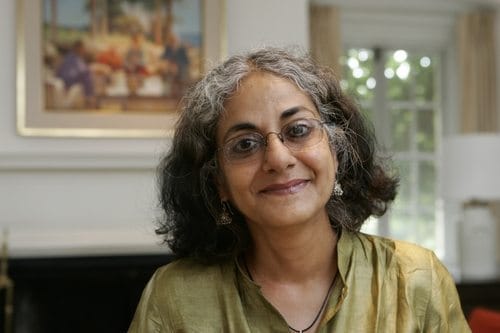
Almost Home: A Memoir Finding a Place to Call Home from Kashmir to New York
By Devinne Zadravec

Almost Home, the latest from author Githa Hariharan is a beautifully crafted memoir about finding one’s place in a global and ever-changing world.
Hariharan was born in Coimbatore, India, and she grew up in Bombay and Manila. She received her education in those two cities and later studied in the United States as well.
Her memoir Almost Home follows her many worldly travels and experiences, deepened by historical asides and cultural explanations. In ten captivating essays, Hariharan explores her life as a global citizen, defined equally by her roots as much as her current address, and what it means to find and embrace her own place in an ancient yet transient world.
Excerpt from the book:
Two Cities of Victory
Hampi 1996, Vijayanagar 1565: The Moving Shall Ever Stay
“Early on a November morning, armed with a water bottle, a notebook, and a pen, I walked down a quiet country road. I was on my way to Hampi, the site of a medieval city. The city was called Vijayanagar, City of Victory, and it was the fabled capital of a great empire in South India.
Vijayanagar was described as a wonder-city by medieval travelers. Firsthand accounts of the city’s best years were written by the Persian ambassador, chronicler and Islamic scholar Abdur Razzaq; by the Portuguese envoy Domingo Paes and his compatriot Fernão Nuniz, a horse trader; by the Italian merchant Niccolò dei Conti, and the Russian traveler Athanasius Nikitin.
They wrote of the lofty stone-built dwellings of royals, nobles, and merchants interspersed with the squalid habitations of the poor; the elaborately built aqueducts which watered the rich gardens and woods lying side by side with luxurious crops of rice and sugarcane; the wonderfully carved temples of Hindu deities, the renowned brahmin colleges and schools; the colorful festivals, the bazaars heaped with pearls, emeralds, and roses; the community of poets, philosophers, musicians, dancing girls,— all the glitter of Hindu medieval court life.
***
When I got to Hampi in 1996, I could only see the ruins of what Hazzaq and company must have seen. What remains of Vijayanagar is on the southern bank of the Tungabhadra River. But “remains” is a misleading word. The site incorporates a progression from plains, to flat land ringed with hills, to mountains with the river flowing around and between. Spread over twenty-six square kilometers is an array of fortification walls, temple complexes, stables, palaces, baths, and watchtowers.
The ruins were unlike anything I had seen before, and most Indians have seen plenty of ruins. But Hampi, like the Vijayanagar that was, offers only a part of itself to the naked eye. The rest, stories that reconstruct the heaps of broken blocks, the crushed masonry and fragments of sculpture, reside in a place accessible only to the imagination.
The landscape before me was certainly real.
It was stark, powerful as if holding out a challenge. Boulders of odd shapes and sizes balanced precariously on each other, casting deep, sharp-edged shadows. These giants of strange shapes surrounded me. Their powerful bodies pierced the skyline; their faces wore a menacing look.

I felt very alone. The routine world and its mundane demands had vanished from view. I had left behind the twentieth century, and with it, all the comforting scenes of rural Karnataka.
Then the silence was broken by tinkling bells. I started, turned around. A girl with a stick was leading her goats, bells round their necks, to graze in the city of victory. She had on a green blouse with puff sleeves and a blue skirt, a size too big for her.
Her long hair was tied with a ribbon, but some strands had escaped and flew wildly about her face. As she passed me, she pointed at a pair of rocks leaning on each other. Akka-thangi, she told me: Big Sister and Little Sister.
Then the girl and the goats went on, leaving me alone again. Only the landscape seemed just a little different. The boulders were still strangely shaped and positioned; they were still far too big. But they now held, in their protective ring, the ruins that stretched in every direction around me, the walls, temples, and palaces that sprouted out of overgrown grass and peered from behind rocks and bushes. Maybe the girl and her sisters of stone had touched the place with magic.
If I looked hard enough, a city may be brought to life.
Buy this book on Amazon.
- The Catskills: Hidden Gems of Upstate New York - July 11, 2017
- Rockport, Massachusetts, Famous Seaport Village - July 14, 2016
- Biking the Globe: Around the World in 6 Years - May 3, 2016




